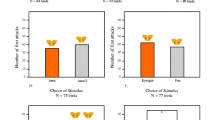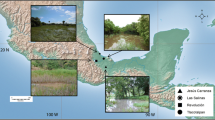Synopsis
The roles of eye camouflage and eyespots are examined within the genusChaetodon as are the various theories explaining the evolutionary significance of the brilliant colors. While eye camouflage is not common among reef fishes, 91% of the 90 species ofChaetodon, have eyemasks (82) or black heads (4). Eye camouflage occurs concomitantly with diurnal false eyespots in 45.5% (41 of 90) of the species. Diurnal false eyespots serve to misdirect attacks by predators and/or to advertise unpalatability. False eyespots are located on areas of the body which allow escape and survival following an attack. Data suggesting that predators learn about the undesirability of butterflyfishes are presented. Butterflyfishes are inactive at night, forage during the day and spawn at dusk. It is unlikely that nocturnal color changes are useful in conspecific interactions and are therefore believed to provide visual cues to potential predators. Nocturnal eyespots probably function to intimidate potential predators but could also remind them of unpalatability. The aggression release hypothesis (Lorenz 1962, 1966) to explain the brilliant coloration of chaetodontids is not supported because butterflyfish coloration changes and few species are territorial. The species recognition hypothesis (Zumpe 1965) is not supported by results of field experiments. The disruptive coloration hypothesis (Longley 1917) is rejected as a general explanation for poster coloration but does explain the prevalence of eyebars ofChaetodon spp. The aposematic hypothesis (Gosline 1965) is supported by morphology, behavior, a lack of predation and field observations. The possibility of Mullerian mimicry is suggested. It is concluded that the primary selective force behind chaetodontid coloration, particularly eyespots, has been predation and color patterns have evolved to minimize this threat.
Similar content being viewed by others
References cited
Allen, G.R. 1980. Butterfly and angelfishes of the world, Vol. 2. Wiley-Interspace, New York. 352 pp.
Alexander, R. 1967. Functional design in fishes. Hutchinson, London. 160 pp
Barlow, G.W. 1972. The attitude of fish eye-lines in relation to body shape and to stripes and bars. Copiea 1972: 4–12
Brower, L.P. 1988. Preface: mimicry and the evolutionary process. Amer. Nat. Suppl. 131: 1–3
Burgess, W.E. 1978. Butterflyfishes of the world. T.F.H. Publications, Neptune City. 832 pp
Cott, H.B. 1957. Adaptive coloration in animals. Methuen Press. London. 508 pp. (Reprinted with minor corrections; first published 1940)
Edmunds, M.E. 1974. Defence in animals: a survey of antipredator defences. Longman, Burnt Mill. 357 pp
Ehrlich, P.R. 1975. The population biology of coral reef fishes. Ann. Rev. Ecol. Syst. 6: 211–247
Ehrlich, P.R., F.H. Talbot, P.C. Russell & G.R. Anderson. 1977. The behavior of chaetodontid fishes with special reference to Lorenz' ‘poster colouration’ hypothesis. J. Zool. Lond. 183: 312–228
Fricke, H.W. 1966. Atrappenversuche mit einigen plukatfarbigen Korallenfishen in Roten Meer. Z. Tierpsychol. 23: 4–7
Fricke, H.W. 1973. Der Einfluss des Lichtes auf Korperfarbund and dammerungsverhalten des Korallenfischen Chaetodon melannotus. Mar. Biol. 22: 251–262
Gawlik, R.J. 1984. Avoidance leaming and memory in the largemouth bass (Micropterus salmoides), fed Bufo tadpoles. Masters' thesis, University of Eastern Illinois, Charleston. 45 pp
Gosline, W.A. 1965. Thoughts on systematic work in outlaying areas. Syst. Zool. 14: 59–61
Guilford, T. 1968. The evolution of conspicuous coloration. Amer. Nat. (Suppl.) 131: 7–21
Hailman, J.P. 1977. Optical signals. Indiana University Press, Bloomington. 362 pp
Hailman, J.P. 1981. A test of symmetry-deception in a chaetodontid fish. Anim. Behav. 29: 1266–1267
Hamilton, W.J.III & R.M. Peterman. 1971. Countershading in the colourful reef fish Chaetodon lunula: concealment, communication, or both? Anim. Behav. 19: 357–364
Hiatt, R.W. & D.W. Strasburg. 1960. Ecological relationships of the fish fauna on coral reefs on the Marshall Island. Ecol. Monogr. 30: 65–127
Hinton, H.F. 1977. Mimicry provides information about the perceptual capacities of predators. Folia Entomol. Mex. 37: 19–29
Hobson, E.S. 1979. Interactions between piscivorous fishes and their prey. pp. 231–242. In: H.E. Clepper (ed.) Predator-Prey Systems in Fisheries Management, Sport Fishing Inst., Washington
Hobson, E.S. 1974. Feeding relationships of teleostean fishes on coral reefs in Kona, Hawaii. U.S. Fish. Bull. 77: 915–1031
Hobson, E.S. & E.H. Chave. 1972. Hawaiian reef animals. University Hawaii Press, Honolulu. 135 pp
Huheey, J.E. 1984. Warning coloration and mimicry. pp. 257–297. In: W.J. Bell & R.T. Cadre (ed.) Chemical Ecology of Insects, Chapman & Hall, London
Huheey, J.E. 1988. Mathematical models of mimicry. Amer. Nat. (Suppl.) 131: 22–41
Kruse, K.C. & B.M. Stone. 1984. Largemouth bass (Micropterus salmoides) learn to avoid feeding on toad Bufo tadpoles. Anim. Behav. 32: 1035–1044
Leccia, F.M. 1970. Estudios preliminares sobre la ecologia de los peces de los Ilanos de Venezuela. Acta Biol., Venezuela 7: 71–102
Levine, J.S., P.S. Lobel & E.F. MacNichol. 1980. Visual communication in fishes. pp. 447–476. In: M.A. Ali (ed.) Environmental Physiology of Fishes, Plenum Press, New York
Longley, W.H. 1917. Studies upon the biological significance of animal coloration. I: The colors and color changes of West Indian reef-fishes. Z. exp. Zool. 1: 533–399
Lorenz, K. 1962. The function of colour in coral reef fishes. Proc. Roy. Inst. Gt. Brit. 39: 282–296
Lorenz, K. 1966. On aggression. Harcourt, Brace & World, Inc., New York. 306 pp
Losey, G.S. 1972. Predation protection in the poison-fang blenny, Meiacanthus atrodorsalis, and its mimics, Ecsenium bicolor and Runula laudandus (Blenniidae). Pac. Sci. 26: 129–139
Losey, G.S. 1978. The symbiotic behavior of fishes. pp. 05–235. In: D.I. Mostofskyz (ed.) The Behavior of Fish and Other Aquatic Animals, Academic Press, New York
McCosker, J.E. 1977. Fright posture of the plesiopid fish Calloplesiops altivelis: an example of Batesian mimicry. Science 197: 400–401
Meyers, R.F. 1980. Chaetodon flavocoronatus, a new species of butterfly fish from Guam. Micronesica 16: 297–303
Motta, P.J. 1984. Response by potential prey to coral reef predators. Anim. Behav. 31: 1257–1259
Myrberg, A.A. & R.E. Thresher. 1974. Interspecific aggression and its relevance to the concept of territoriality in fishes. Amer. Zool. 14: 81–96
Neudecker, S. 1979. Effects of grazing and browsing fishes on the zonation of corals in Guam. Ecology 60: 666–672
Neudecker, S. & P.S. Lobel. 1982. Mating systems of chaetodontid and pomacanthid fishes at St. Croix. Z. Tierpsychol. 59: 299–318
Pasteur, G. 1982. A classificatory review of mimicry systems. Ann. Rev. Ecol. Syst. 13: 169–199
Pough, F.H. 1988. Mimicry of vertebrates: are the rules different? Amer. Nat. (Suppl.) 131: 67–102
Randall, J. 1967. Food habits of reef fishes of the West Indies. Stud. Trop. Oceanogr. 5: 665–847
Randall, J.E. & H.A. Randall. 1960. Examples of mimicry and protective resemblance in tropical marine fishes. Bull. Mar. Sci. Gulf Caribb. 10: 444–480
Rasa, O.A.E. 1969. Territoriality and the establishment of dominance by means of visual cues in Pomacentrus jenkinsi Pisces: Pomacentridae. Z. Tierpsychol. 26: 825–845
Reese, E.S. 1973. Duration of residence by coral reef fishes on ‘home’ reefs Copiea 1: 145–149
Reese, E.S. 1975. A comparative field study of the social behavior and related ecology of reef fishes of the family Chaetodontidae. Z. Tierpsychol. 37: 37–61
Reighard, J. 1908. An experimental study of warning coloration in coral reef fishes. Pap. Tortugas Lab. 2: 257–325
Rettenmeyer, C.W. 1970. Insect mimicry. Ann. Rev. Entomol. 15: 43–74
Rothschild, M. 1964. An extension of Dr. Lincoln Brower's theory on bird predation and food specificity, together with some observations on bird memory in relation to aposematic colour patterns. Entomologist 1964: 73–78
Rothschild, M. 1972. Colour and poisons in insect protection. New Sci. 54: 318–320
Steene, R.C. 1978. Butterfly and angelfishes of the world, Vol. 1. John Wiley & Sons, New York. 144 pp
Thresher, R.E. 1977. Eye ornamentation of Carribbean reef fishes. Z. Tierpsychol. 43: 152–158
Waldbauer, G.P. 1988. Asynchrony between batesian mimics and their models. Amer. Nat. (Suppl.) 133: 103–121
Wickler, W. 1968. Mimicry in plants and animals. McGraw-Hill, New York. 255 pp
Zaret, T.M. 1977. Inhibition of cannibalism in Cichla ocellaris and hypothesis of predator mimicry among South American fishes. Evolution 31: 421–437
Zumpe, D. 1965. Laboratory observations on the aggressive behavior of some butterfly fishes Chaetodontidae. Z. Tierpsychol. 22: 226–236
Author information
Authors and Affiliations
Rights and permissions
About this article
Cite this article
Neudecker, S. Eye camouflage and false eyespots: chaetodontid responses to predators. Environ Biol Fish 25, 143–157 (1989). https://doi.org/10.1007/BF00002208
Received:
Accepted:
Issue Date:
DOI: https://doi.org/10.1007/BF00002208




